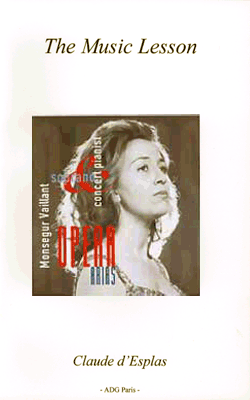
|
The Music Lesson
Claude d'Esplas
|
THE MUSIC LESSON
The Music Lesson, Scene of The Barbier of Seville by Rossini
In the ‘music lesson’ scene of the Barber of Seville by Rossini, the direction reads: ‘Rosine sings an air, ad libitum, for the occasion’. Rossini thus permitting, Madame Garcia-Viardot — the Sapho of a Charles Gounod whose writing was still under the spell of the lower register of Pauline (ô Carvalho,ô Saint-Saëns!) would sing a Spanish song, whereas Adelina Patti used to warble the Bolero from Les Vêpres Siciliennes by the Verdi of ‘La Grande Boutique’; as to Madame Sembrich seating herself at the pianoforte, she would sing Chopin’s Maiden’s wish while Nelly Melba used to intone the ‘Mad scene’ from Lucia di Lammermoor (Donizetti) ending with Tosti’s Mattinata to which she played her own accompaniment. Astrofiammante Galli-Curci would simply trill the ‘cocottes’ of the so-called ‘vengeance aria’ (Die Zauberflöte, Mozart) also to her own accompaniment. All those feats being but the happy conclusion of the ‘music lesson’ in which every Cinderella-Rosina must strip of the shreds of a supposedly beginner stammering out her lesson, to don the robe of the most accomplished of prima donnas.
In the wake of such renowned sherpa-predecessors, Monsegur Vaillant, one of the bellissime Rosinas ever (see Highlights), seating herself at her piano and singing to her own accompaniment, unfussed by the Précieuses de Salon, inhabiting the music from within and getting everything come è scritto, unleashes her silver-tinged accents devoid of any artificial ‘velouté’ à la mode du Chef (ô Rossini!) throughout these six operatic roles, acme of bel canto, that flow so naturally and unite ‘in an eternal embrace, the couplet and the song, the ivy and the vine, the draught and the cup’, in the very words of Claude d’Esplas (Tristan & Isolt, IMA Press, Moscow 1994).
Claude d‘Esplas (The Music Lesson)
All rights reserved
